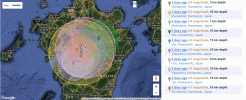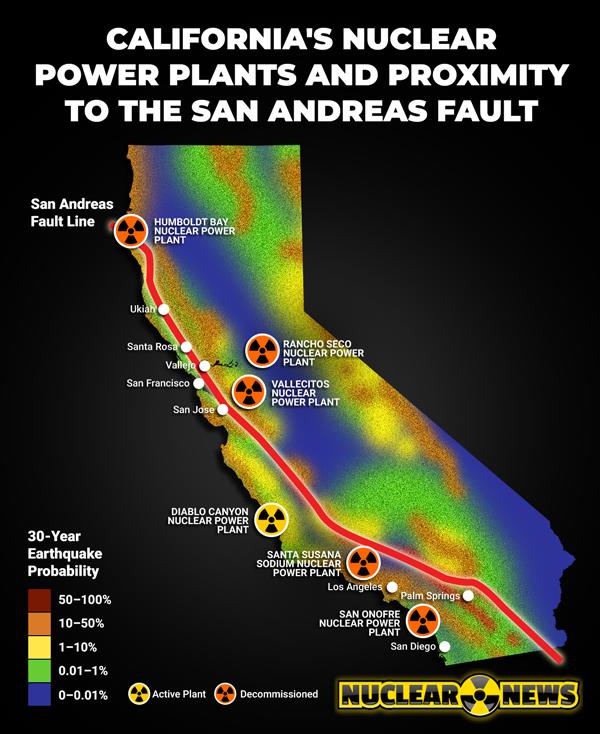A
Anders
Guest
There has been a lot of talk and a couple of documentaries in recent times pertaining to show the valeur of Nuclear Power as the saviour for energy-hungry people around the world and with the apparent benefit of stopping Green house gasses and thus slow global warming. There are currently about 440 nuclear reactors operating around the world.
As I mentioned at the end of thread http://www.cassiopaea.org/forum/index.php?topic=1027
Indonesia is one of these countries looking to nuclear energy. One article in Jakarta Post (http://e.sinchew-i.com/content.phtml?sec=2&artid=200604280000) says:
For general info, Indonesia sits on the "Pacific rim of fire", a map with earthquake epicentre for activity >5 between 1980-1990 is found here http://www.windows.ucar.edu/tour/link=/earth/images/RIM_of_FIRE_gif_image.html&edu=high
So without even taking into account cyclical comet showers, global warming with resulting rising sealevels, likely increased hurricane activity and intensity (with the probable flow on effect of stimulating earthquakes) this appears to me to be globally irresponsible.
In regard to the known case of a limited nuclear disaster namely Chernobyl then the effects were and still are widespread. Reports on our own Forum here from Turkiye and Greece attest to that http://www.cassiopaea.org/forum/index.php?topic=1298
This article in Pravda http://english.pravda.ru/topic/Chernobyl-119/ which commemorates the 20th anniversary says:
As I mentioned at the end of thread http://www.cassiopaea.org/forum/index.php?topic=1027
My attention got caught on SOTT article from the 10th of May where it reads:The nuclear industry for energy production today relies on a stable society where the whole infrastructure is functioning. In case of a slight accident, emergency procedures and contingency plans are activated, yet these plans rely on
1) Power supply
2) People to implement the emergency procedures and contingency plans
3) Helicopter and aircraft to encapsulate the reactor as seen with Chernobyl
4) Normal infrastructure such as roads, communications network etc.
So we see that a small quake by normal standards can severely unstabilise an infrastructure in a region.Earthquake leaves 10 million Philippines residents without power
Manila Standard
10/05/2006
An earthquake that damaged a transmission tower and shut down four power plants left more than 10 million people in Cebu without electricity yesterday, officials and residents said.
The relatively mild quake, measuring 3.7 on the Richter scale, struck Leyte at 10:02 a.m, the seismology office in Manila said, triggering a chain reaction of power generation units shutting down.
Indonesia is one of these countries looking to nuclear energy. One article in Jakarta Post (http://e.sinchew-i.com/content.phtml?sec=2&artid=200604280000) says:
In the last few days we have heard that one of the volcanoes in Indonesia is on red alert. So apart from earthquake risk which is mentioned in the Jakarta Post article there is also a volcano. As a matter of fact there are at least 130 active volcanoes in Indonesia according to this site http://www.geology.sdsu.edu/how_volcanoes_work/Krakatau.html which also mentions the eruption in 1883 of Krakatau. Location of the some of the volcanoes are shown on a map for those interested.A nuclear power plant for Indonesia is now on the front burner. Soedyartomo Soentoro, head of the National Nuclear Energy Agency (Batan), says the nation needs 100 gigawatts of electric power by 2025. Four nuclear power plants would provide a total of 4 gigawatts.
He gave a nuclear plant timetable: in 2006 the site permit is procured, 2008 bidding opens, 2016 plant in operation, 2017 commercial use begins.
The most probable site is 7km from the Tanjung Jati B power plant on Muria Peninsula on the north coast of Central Java. The site is in Jepara regency near Mount Muria, an inactive 1,602m volcano. The Muria area is chosen because of the relatively low probability of an earthquake occurring there.
Geologists say Kalimantan would be a better site as it is less vulnerable to quakes. But as more than 60% of Indonesia's electricity needs are in Java, Bali and Madura, a future chain of nuclear plants will be built on and for these three islands.
For general info, Indonesia sits on the "Pacific rim of fire", a map with earthquake epicentre for activity >5 between 1980-1990 is found here http://www.windows.ucar.edu/tour/link=/earth/images/RIM_of_FIRE_gif_image.html&edu=high
So without even taking into account cyclical comet showers, global warming with resulting rising sealevels, likely increased hurricane activity and intensity (with the probable flow on effect of stimulating earthquakes) this appears to me to be globally irresponsible.
In regard to the known case of a limited nuclear disaster namely Chernobyl then the effects were and still are widespread. Reports on our own Forum here from Turkiye and Greece attest to that http://www.cassiopaea.org/forum/index.php?topic=1298
This article in Pravda http://english.pravda.ru/topic/Chernobyl-119/ which commemorates the 20th anniversary says:
It just makes me wonder what happened to common sense...The explosion of the nuclear reactor of the Chernobyl power plant contaminated a vast territory of the European continent
A serious catastrophe is likely to occur on the Chernobyl nuclear power plant in 2006. The disaster may become even more serious than the world-known blast of the station, which occurred on April 26th 1986. Specialists installed a sarcophagus around the nuclear reactor that year – the sarcophagus was supposed to protect the world from the harmful influence of radiation coming from the remnants of the hazardous production for 20 years. The warranty period has already elapsed





 Diablo Canyon Nuclear Power Plant. Image source: Wikimedia
Diablo Canyon Nuclear Power Plant. Image source: Wikimedia
 Diablo Canyon Nuclear Power Plant is due to stay operational till the mid-2020's. Image via LA Times
Diablo Canyon Nuclear Power Plant is due to stay operational till the mid-2020's. Image via LA Times